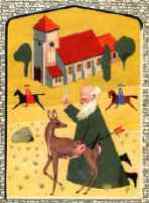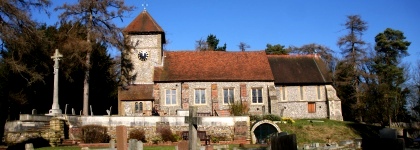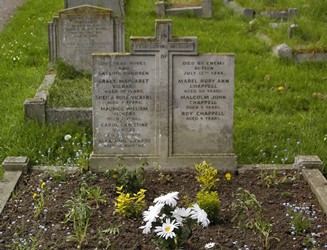


WAR GRAVES IN FARNBOROUGH CHURCHYARD
The Churchyard at St. Giles has thirteen memorials to registered war dead, five from World War 1 and eight from World War 2. There are also of course the graves of local civilians who died during the war, some in tragic circumstances. Foremost among the latter were two families who died while on the way to being evacuated away from London. See the panel to the right.
Shown below are photographs of the 13 official war grave memorials. As may be seen not all are of the standard War Grave memorial design, and some also commemorate family members who died later. Some died from their injuries after the end of hostilities..
Shown with each photograph is a grave number. Researchers wishing to find a grave should contact the Parish Office in the first instance to arrange a visit, during which assistance finding a grave can be given. We do not publish the full graveyard map.
Further details may be found Here and also by submitting a Farnborough Churchyard search on the Commonwealth War Graves Commission website.
Click on Photos to enlarge
About War Graves
A war grave is a burial place for members of the armed forces or civilians who died during military campaigns or operations. The term does not only apply to graves: ships sunk during wartime are often considered to be war graves, as are military aircraft that crash into water; this is particularly true if crewmen perished inside the vehicle.
Classification of a war grave is not limited to the occupier's death in combat but includes military personnel who die while in active service: for example, during the Crimean War, more military personnel died of disease than as a result of enemy action.
A common difference between cemeteries of war graves and those of civilian peacetime graves is the uniformity of those interred. They generally died during a relatively short period, in a small geographic area and consist of service members from the few military units involved.
The Commonwealth
War Grave Commission is currently responsible for the
continued commemoration of 1.7 million deceased Commonwealth military
service members in 153 countries and approximately 67,000 civilians who
died as a result of enemy action during World War II. Commonwealth
military service members are commemorated by name on either a headstone,
at an identified site of a burial, or on a memorial. As a result, the
Commission is currently responsible for the care of war dead at over
23,000 separate burial sites and maintenance of more than 200 memorials
worldwide
The vast majority of burial sites are pre-existing communal or
municipal cemeteries and parish churchyards located in the United
Kingdom, however the Commission has itself constructed
approximately 2,500 war cemeteries worldwide. The Commission has
also constructed or commissioned memorials to commemorate the dead
who have no known grave; the largest of these is the Thiepval
Memorial.
PARISH HISTORY
A Tragic Incident for Farnborough
Of course not all deaths in wartime are of serving personnel.The Parish Office was recently contacted by a Mr Roger Taylor regarding the grave of two of his aunts and their children, his cousins. He was concerned that because he lives in Sussex and is in his eighties, he is finding it difficult to come to the Churchyard on a regular basis to keep the grave tidy.
The grave concerned is a large square plot with a headstone inscribed “IN EVER LOVING MEMORY OF OUR DEAR WIVES AND DARLING CHILDREN. Died by enemy action July 13th, 1944”. Eight names are listed: - Grace Margaret Vickers (35) and her children Sheila (9) Maurice (7) Carol (5) and Alan (18 months). Mabel Ruby Ann Chappell (30) and her children Malcolm (5) and Roy (4)
The two young mothers were the middle of the four Staples sisters. Ivy Rose Taylor being the eldest and Daisy Staples being the youngest. During the Second World War both their husbands were away in the Forces and Grace with her children and Mabel with her children shared a house together in Palmerston Road, Farnborough Village. At that time quite a dangerous place to be, being close to Biggin Hill Aerodrome and fighter station. In an area nicknamed “Bomb Alley “
They endured the first four years of the war there, going through the Blitz and regular bombings. However, in 1944 the Germans started using the V1 unmanned flying bombs, nicknamed Doodlebugs. They had a noisy engine, that once out of fuel would plummet randomly to the ground. These must have terrified them, because they decided to go and stay with relatives in the north of England, a safer place.
On the morning of the 13th July they got a taxi to take them to King’s Cross station. They travelled through Bromley, down Bromley Hill, on to Southend Pond and the Tiger’s Head public house. There, at 9:50am, they received a direct hit from a V1 and were all killed instantly. It is unimaginable how devastated their husbands and other family members must have been.
There is a happier footnote to this dreadful event. Ivy and her husband George had two children, Gordon who is now ninety and Roger eighty-four (who contacted the Parish Office about this). Both brothers have two daughters. Roger’s being Janet and Sonya. After the war and later, the widower of Mabel, John Chappell married Daisy the youngest sister. They went on to have two daughters of their own, Wendy and Marion. I understand that later the widower of Grace also married again.
The Churchyard group of volunteers who meet every Tuesday morning to help maintain it to a high standard were informed of what Mr Taylor had said, and as it is a War Grave, instantly agreed to assist with the project.
It was decided to remove all the weeds, clear the site, add a lot of compost, level, and lay turf. Crocus bulbs were planted underneath. The stonework had 79 years of grime and dirt on and was difficult to read. This has now been cleaned.

The photos above show the grave before and after the work was carried out, in September 2023 .
Ian Chandler